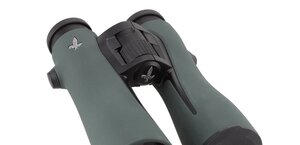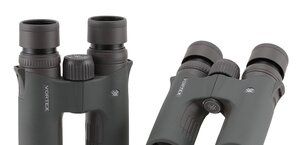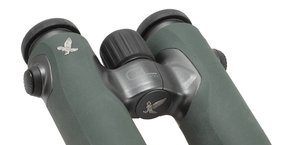| Real front lens diameter |
Left: 49.82+/-
0.05 mm
Right: 49.9+/-
0.05 mm
|
8 / 8.0 pkt |
| Real magnification |
11.91+/-
0.05x
|
3/3.0 |
| Transmission |
77.5+/-
1%
|
8/25.0 |
| Chromatic aberration |
Really slight in the centre, but, unfortunately,high on the edge. |
5.5/10.0 |
| Astigmatism |
Very good result at this price point. Images of stars spark very slightly. |
7/10.0 |
| Distortion |
The distance of the first curved line from the field centre compared to the field of view radius: 82% ± 3% |
10/10.0 |
| Coma |
Coma appears already in a distance of 65% of field of view radius and is high on the very edge. |
4.2/10.0 |
| Blurring at the edge of the FOV |
Blur occurs in a distance of 63% ± 4% form the field of view centre. |
1/10.0 |
| Darkening at the edge the FOV |
Moderate. |
3.2/5.0 |
| Whiteness of the image |
Distinct yellow-orange hue. |
2.9/5.0 |
| Collimation |
Perfect. |
5/5.0 |
| Internal reflections |
| Left: |
Right:
|
 |
 |
There are no bright spots but the whole area around the exit pupil is gray and not properly contrasted. |
2.8/5.0 |
| Housing |
Solid, classic Porro. Rubber armour slightly rough, very pleasing to the touch but also easy to catch dirt. On the other hand it sticks to your hands very well and more ribbed parts under your thumbs improve the grip even further. Rubber near objectives sticks out a bit but everywhere else it is properly glued. No excess of glue or squelching. Rubberized eyecups with 4 detention stops. Made in China. |
7/8.0 |
| Focusing |
Big, comfortable central wheel with ribs, joined with a classic open bridge. The wheel moves smoothly and is properly damped. Running through the whole range takes a turn through an angle of 450 degrees. Eyepieces wobble sideways quite a lot but the instrument doesn't get defocused under pressure. The bridge performs quite evenly. |
3/5.0 |
| Tripod |
There is a comfortable tripod exit. |
3/3.0 |
| Interpupilary distance |
from 54.6 to 75.7mm
|
5/6.0 |
| Closest focusing distance |
5.95 meters. |
1/2.0 |
| Eyepieces FOV |
Apparent field of view of 59.7 degrees (according to simplified formula) and 55.0 degrees (according to tangent formula). |
11/20.0 |
| Field of view |
Measured by us amounted to 5.01 ± 0.06 degrees and was narrowed than stated in official specifications. A typical field for this class of equipment. |
5/8.0 |
| Quality of the interior of the barrels |
Black, very well matted tubes but without any ribs or apertures. Gray, quite bright bottom. A lot of gray glue near the prisms but surprisingly clean inside! |
3.3/5.0 |
| Vignetting |
| Left: |
Right:
|
 |
 |
OL: 1.19%, OP: 0.80% |
6.5/8.0 |
| Prisms quality |
Good quality BaK-4. |
8/8.0 |
| Antireflection coatings |
Greenish on the objective lens but just from one side – the other one is not covered by anything. Prisms are also very shiny. Green on eyepieces but 1-2 air-to-glass surfaces are not covered by anything. Medium intensity. |
2.5/5.0 |
| Warranty [years] |
10 |
4.5/6.0 |
| Final result |
63.4%
|
120.4 / 190 pkt
|
| Econo result |
|
0pkt. |
Summary
Pros:
- solid casing for this price point,
- good correction of astigmatism,
- very low distortion,
- sensible apparent field of eyepieces,
- low vignetting or prisms made of BaK-4 glass,
- moderate brightness loss on the edge of the field of view,
- more or less circular exit pupils against a quite dark background,
- sensible price/performance ratio.
Cons:
- weak correction of chromatic aberration on the edge of the field,
- distinct coma,
- weak sharpness of images on the edge of the field,
- noticeable yellowish hue of images,
- stability of the bridge could have been better.
The ACULON A211 series are the cheapest Porro pairs of binoculars offered by this renowned Japanese producer. In order to keep the price low, on a level of 100 USD, they decided to economize a lot. Forget about efficient antireflection coatings – the ones, used here, are the simplest; what's more, they don't even cover all air-to-glass surfaces. The result is easy to predict – it's enough you glance at the transmission graph below.
In the centre of the visible spectrum the instrument barely brushes agains 80%, a weak result in case of a Porro device with efficient prisms. What's more, the graph is distinctly slated, with a prominent loss of purple and blue light; that's why images are dominated by yellow colouring. Perhaps the situation is not as weak as in old PZO and BPC pairs of binoculars but it hardly meets contemporary standards.
However, the binoculars also feature several assets, especially taking its price point into account. The quality of images in the field centre is really sensible – mainly due to good astigmatism correction and low chromatic aberration. You should praise distortion correction as well.

Nikon Aculon A211 12x50 and Nikon Action EX 12x50 CF. |
Unfortunately, all these efforts are sufficient only for correction of the centre of the field of view; the edges are very weak, with a very fast decrease of sharpness, suffering also from negative influence of high levels of coma and chromatic aberration.

Nikon Aculon A211 12x50, Nikon Action EX 12x50 CF and Nikon SE 12x50 CF. |
That's why you can recommend the Nikon Aculon A211 12x50 only to buyers with really limited budgets. Of course such a purchase is definitely a better idea than looking for cheap binoculars on different Internet auction sites – contrary to other obscure producers Nikon still implement control quality and their warranty is not fictional. However, you have to be aware of the fact that with a just slightly higher budget you would be able to buy an instrument of noticeable better optical and mechanical quality.






















